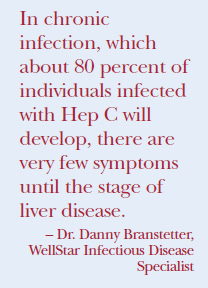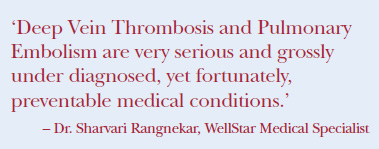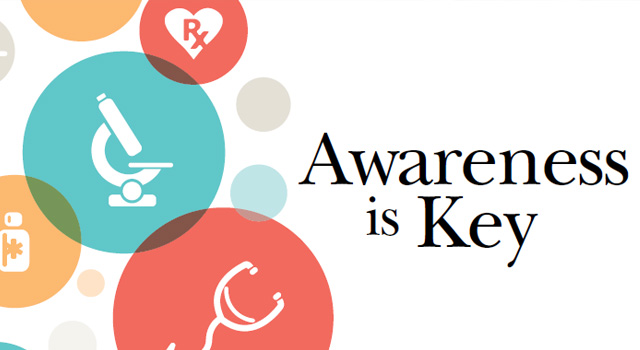Believe it or not, there are medical conditions affecting our family members, friends, neighbors or co-workers that we know very little about or that they even exist. Two such illnesses include Hepatitis C and Deep Vein Thrombosis and Pulmonary Embolism (DVT/PE). Hep C is a viral infection that affects primarily liver cells and multiple strains exist, and DVT/PE is a condition that occurs when a blood clot forms in a deep vein.
 “Hep C is a chronic infection, which multiple health problems can arise,” says Dr. Danny Branstetter, infectious disease specialist for WellStar Health System. It affects all ages, genders and races, but higher incidence is reported in individuals born between 1945-1965. Other at-risk groups include: injection drug users, including one-time users and even if it was a “long time ago;” recipients of blood transfusions, blood products or an organ transplant before 1992; homemade tattoos or piercing where someone used non-sterile equipment; and infants born to Hep C positive mothers. Less frequent transmission, Branstetter says, includes individuals who share personal items like a toothbrush or razor with a Hep C patient, and someone who has sex with someone who has Hep C.
“Hep C is a chronic infection, which multiple health problems can arise,” says Dr. Danny Branstetter, infectious disease specialist for WellStar Health System. It affects all ages, genders and races, but higher incidence is reported in individuals born between 1945-1965. Other at-risk groups include: injection drug users, including one-time users and even if it was a “long time ago;” recipients of blood transfusions, blood products or an organ transplant before 1992; homemade tattoos or piercing where someone used non-sterile equipment; and infants born to Hep C positive mothers. Less frequent transmission, Branstetter says, includes individuals who share personal items like a toothbrush or razor with a Hep C patient, and someone who has sex with someone who has Hep C.
The infectious disease is most commonly asymptomatic, which means a patient will not look or feel sick, and most individuals would not be aware of having the infection without being tested. Branstetter says an estimated 2.7 million people are infected in the United States, and doctors diagnose about 30,000 cases each year.
He adds that in an acute infection, only about 20-30 percent are symptomatic (showing symptoms of the disease) enough to make someone seek medical attention. Most report a fever, abdominal pain, jaundice (a yellow tint to skin and eyes) and a poor appetite. “Other symptoms that are common among all viral infections, including the common cold, are fever, joint aches, fatigue, nausea, vomiting, changes in the color of stool (lightening) and urine (dark) are also possible,” Branstetter continues. “These usually occur around 4-12 weeks after infection.”
In chronic infection, which about 80 percent of individuals infected with Hep C will develop, there are very few symptoms until the stage of liver disease. “The paucity of symptoms recognizable by individuals, as well as healthcare providers, stresses the importance of testing,” he says. “Healthcare providers may be able to detect abnormalities in liver function tests on routine screening.” He adds that multiple health problems, including Cirrhosis and liver cancer, are a result of the infection, and complications from and directly related to Hep C can lead to death.
However, Branstetter says thereare multiple treatment options, some with cure rates greater than 95 percent in less than eight weeks. “Specific treatment options are individualized based on the strain of Hepatitis C and co-morbidities along with the stage of liver disease present,” he says, adding that increased awareness and new treatment options are leading to increased testing by health professionals and an increased number of individuals seeking testing and treatment.
It Can Happen to Anybody
“Grossly” under diagnosed, yet preventable, Dr. Sharvari Rangnekar, a WellStar medical specialist in Marietta, says DVT/PE is a result of blood clots that usually develop in the lower leg, thigh or pelvis but can also occur in the arm. PE is a condition where blood clots are developed in the lungs. Usually, the cause of this is a clot migrating from some other parts of the body, mainly from DVT.

“It is important for the public to know about DVT/PE because they can happen to anybody and can cause serious illness, disability and in some cases, death,” Rangnekar says. “The good news is that DVT is preventable and treatable if discovered early. PE is a condition where blood clots are developed in the lungs. Usually the cause of this is a clot migrating from some other parts of the body, mainly from DVT.”
In September 2014, the Cobb County Board of Commissioners signed a proclamation at the request of the Georgia Thrombosis Forum in honor of Thrombosis Awareness Month. Rangnekar is a member of GTF and serves on the committee for the Patient Support Group within the organization. Dr. Atul Laddu, a retired physician/researcher from Suwanee, founded GTF in 2011 with a mission to spread awareness of thrombosis throughout Georgia.
“The incidence of thrombosis is very high, yet not known to many people,” Laddu says. At just 14 years old, his grandson suffered two massive clots in both of his lungs after a prolonged back surgery. “While statewide and citywide numbers on thrombosis are not widely available, nationwide numbers are very alarming,” Laddu says. “Thrombosis, including DVT and PE, affects around 300,000–600,000 people in the United States annually, according to the CDC.” The Surgeon General has determined 100,000–180,000 people die every year due to thrombosis — that is more than breast cancer and AIDS combined. “One person is diagnosed with a blood clot every minute,” Laddu continues. “One person dies from a blood clot every six minutes. The total cost of treating these conditions in the U.S. is in excess of $8 billion.”
DVT is one of the most preventable conditions, Laddu says. Simple lifestyle changes, such as a nutritious diet, regular exercise, weight control, drinking a lot of fluid, not sitting for long periods of time, frequent getting up and walking during airplane travel and frequent breaks during long drives are some simple techniques that will help you avoid getting these conditions. A physician diagnoses thrombosis, but family members could get an early sign that their loved ones may get into trouble. Leg pain, leg swelling, difficulty in breathing, chest pain, numbness in arms and disorientation could be the early symptoms that could warn a visit to the doctor or ER.
One aspect that sets GTF apart from other medical organizations is its youth initiative. Varun Rangnekar, a student at Johns Creek High School and Dr. Rangnekar’s son, is one of 12 young people who help plan and manage a majority of the forum’s work. “This burning passion from the youth is the primary reason for the success of this forum,” Varun Rangnekar says. “We wish to educate the community about this condition and some simple prevention techniques.” Young members give a presentation annually before the Harvard University and North American Thrombosis Forum, as well as obtain proclamations signed by state, county and city officials regarding the importance of thrombosis awareness, meet with critical contacts and organize booths at various festivals and events to share information about GTF and this condition.
“[GTF] has provided me with an opportunity to further my passion of educating the community about the dangers of thrombosis,” Varun Rangnekar says. “Working with Dr. Laddu has been a great learning experience that has allowed me to transfer my energy in a positive direction while giving back to the community.”
To learn more about thrombosis, visit GTF online at gtfonline.com, the North American Thrombosis Forum website natfonline.org or search for “DVT” on medicinenet.com.
















